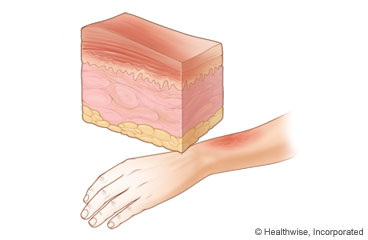
Overview
Burns can occur when a harmful chemical, such as a cleaning product or an acid, splashes onto the skin. The amount of damage to the skin depends on how strong the chemical was, how much of it was on the skin, and how long it was there. Chemical burns, even minor ones, can be very painful. A minor burn may heal within a few days. But a more serious burn may take weeks or even months to heal completely.
When the skin is damaged by a burn, it may become infected. You can help prevent infection and help your child's burn heal. Keep the burn clean, and change the bandages often. Taking good care of the burn as it heals may help prevent bad scars.
The treatment for most chemical burns is to remove the chemical from the skin by flushing the area with plenty of water. But some chemicals can't be removed with water. They may need to be removed from the skin in other ways by the doctor.
The doctor has checked your child carefully, but problems can develop later. If you notice any problems or new symptoms, get medical treatment right away.
Follow-up care is a key part of your child's treatment and safety. Be sure to make and go to all appointments, and call your doctor if your child is having problems. It's also a good idea to know your child's test results and keep a list of the medicines your child takes.
How can you care for your child at home?
- If your doctor told you how to care for your child's burn, follow your doctor's instructions. If you did not get instructions, follow this general advice:
- Wash the burn every day with a mild soap and water. Don't use hydrogen peroxide or alcohol, which can slow healing.
- Gently pat the burn dry after you wash it.
- You may cover the burn with a thin layer of antibiotic ointment or petroleum jelly and a nonstick bandage.
- Apply more ointment and replace the bandage as needed.
- Be safe with medicines. Read and follow all instructions on the label.
- If the doctor gave your child a prescription medicine for pain, give it as prescribed.
- If your child is not taking a prescription pain medicine, ask your doctor if your child can take an over-the-counter medicine.
- Don't break blisters open. Broken blisters could get infected. If a blister breaks open by itself, blot up the liquid, and leave the skin that covered the blister. This helps protect the new skin.
- Teach your child to try not to scratch the burn. Talk to your doctor about what to use on the burn for itching.
When should you call for help?
Call your doctor now or seek immediate medical care if:
- Your child's pain gets worse.
- Your child has symptoms of infection, such as:
- Increased pain, swelling, warmth, or redness.
- Red streaks leading from the burn.
- Pus draining from the burn.
- A fever.
Watch closely for changes in your child's health, and be sure to contact your doctor if:
- The burn is not getting better each day.
Current as of: November 16, 2023
Author: Ignite Healthwise, LLC Staff
Clinical Review Board
All Healthwise education is reviewed by a team that includes physicians, nurses, advanced practitioners, registered dieticians, and other healthcare professionals.

